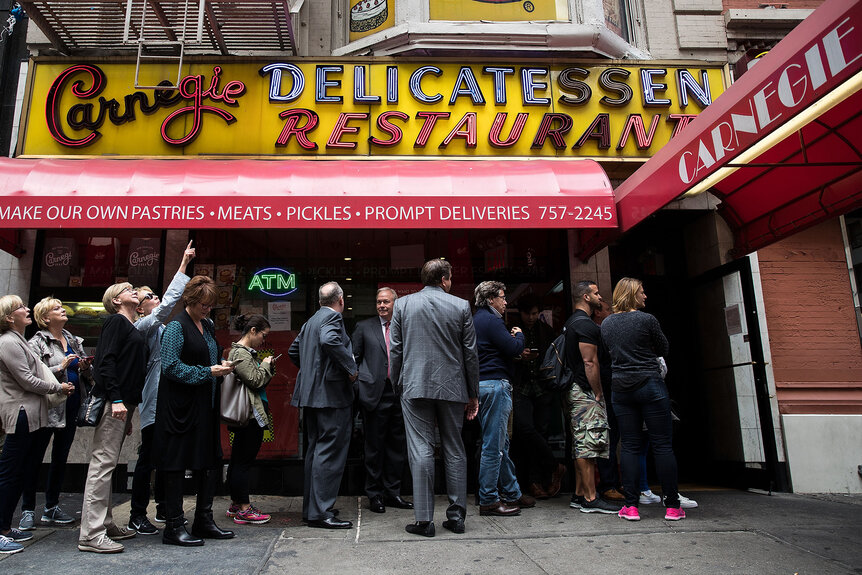Create a free profile to get unlimited access to exclusive videos, breaking news, sweepstakes, and more!
Dirty Dancing Actress Shot Execution Style in 2001 Carnegie Deli Murders
N.Y.P.D. detectives had to find who shot rising actress Jennifer Stahl and her friends in what appeared to be a robbery gone wrong
In the heart of Midtown — where tourists flock to see some of New York City’s most famous sites — was Manhattan’s Carnegie Deli, famous for its cheesecake, pastrami sandwiches, and other delicatessen eats. But in the springtime of 2001, it became the epicenter of a shocking murder that left a rising star and four others shot in a robbery gone wrong.
On May 10, 2001, shortly after 7:30 p.m., N.Y.P.D. officers were dispatched to an apartment above Carnegie Deli. A man named Anthony Veader called 9-1-1 after freeing himself from restraints, claiming he and others in the apartment had been shot, Manhattan Assistant District Attorney Steven Nuzzi told New York Homicide, airing Saturdays at 9/8c on Oxygen.
RELATED: Detectives Search For Who Stabbed Beloved Spanish Harlem Role Model More Than 50 Times
Who were the victims of the Carnegie Deli murders?
Officers arriving on the scene, including Officer Karen Pan, described finding a woman “with blood all over her clothes and in her hair” standing on the landing of a staircase. The unknown woman — later identified as Rosemond Dane — had her hands behind her back, and authorities were uncertain whether she was armed.
“When we asked her to move to the side, she stared at us,” Pan recalled. “And then she actually fainted.”
Dane’s hands were duct-taped behind her back.
Upon entering the apartment, police found an injured Veader. Two other men — later identified as Stephen King and Charles “Trey” Helliwell — were also found duct-taped, though dead on the scene. According to Pan, they soon found the apartment’s renter, Jennifer Stahl, 39, in a makeshift music studio adjacent to the living room. She was alive but “struggling to breathe,” Pan told New York Homicide.
Each of the five victims had been shot in the back of the head.
A Carnegie Deli employee later told detectives she saw two Black men running away from the building at the time of the homicides, one with dreadlocks.
Dane, Veader, and Stahl were rushed to a nearby hospital, though Stahl would succumb to her injuries before morning.
Who was Jennifer Stahl?
News of the horrific attack brought hordes of media outlets to Carnegie Deli, though rare was a murder in such a touristy section of the city. Coverage was amplified when it was discovered Stahl was an up-and-rising actress, dancer, and singer who’d managed to get a small part in the hit 1987 film Dirty Dancing, just two years after moving to the Big Apple.
“Jen wanted to be a star,” friend Barbara Coleman told New York Homicide. “New York is where everything happens.”
Police soon learned from the crime scene that Stahl also had a rather lucrative side hustle by selling marijuana, catering to a clientele in the city’s theater and media districts.
“There were a bunch of jars, and all the jars had buds of marijuana in them,” according to Det. Irma Rivera. “I realized that this was not a weed that people sell on the street; it seemed more like gourmet weed to me.”
Stahl had a vast network of friends and “accomplished musicians” who visited the apartment on any given day. A passion for music led her into the arms of her boyfriend, a drummer who matched the description of one of the two men seen running away from the crime scene.
Friend Katya Surrence told New York Homicide that there was “a little bit of violence” between Stahl and her partner. In fact, just days before the attack, Stahl had broken her pinkie during an alleged altercation with the drummer. But though friends had their suspicions, Stahl’s boyfriend had an alibi and was quickly ruled out as a suspect.
Investigators turned their attention toward Stahl’s marijuana business.
“Jen had a variety of clientele,” said Stahl’s friend, Michelle Cramer. “She had people who worked in the music industry, rappers, producers, and it was just a lot of her long-time friends.”
The Statements of the Surviving Victims
Veader, Stahl’s friend and hairdresser, was still hospitalized for his injuries. As was Dane, who was hanging out with her boyfriend, Trey Helliwell, and the rest before Helliwell was shot to death. Stephen King was also a long-time friend of Stahl’s, an expectant father whom Stahl hired to watch the door as business and foot traffic increased over time.
“She thought she was safe,” Coleman told New York Homicide. “She said, ‘Cocaine kicks your door in in the middle of the night, marijuana doesn’t.’”
Police found no reason for any of Stahl’s guests to be targeted for murder. Lieutenant Commander Roger Parrino for the Manhattan North Precinct told New York Homicide that it appeared to be a robbery or drug deal gone very wrong.
Surveillance video from Stahl’s hallway showed two men — whose descriptions that the Carnegie Deli worker gave police — calmly going upstairs toward Stahl’s apartment and running away moments later, one of them carrying a backpack on the way out.
A witness also reported the two suspects getting into a car suspiciously parked around the corner from the crime scene. Following the lead, police found a summons was issued in the area to a vehicle registered to Andre Smith.
Days later, Veader and Dane — still recovering from their injuries — were healthy enough to speak with detectives. Both victims said they were hanging out at the apartment when someone named “Sean” buzzed up. With Stahl’s permission, King let Sean and his friend enter the apartment, before the two suspects announced they were there to rob them. Rosemond Dane tried to run before one of the men pulled her back.
“One of them started duct-taping people as they laid face down on the living room floor,” said Det. Billy McNeely. “And the other grabbed Jennifer [and] took her into the studio… Rosemond Dane heard her say, ‘Just take what you want. Please, just don’t hurt anybody.’”
Neither of the surviving witnesses could report who pulled the trigger, though Veader — who played dead — and Dane sustained head wounds that never entered the skull.
Police Identify Suspect No. 1
The name “Sean” rang familiar to Stahl’s friends, and one remembered that a man named Sean Salley had recently submitted a resumé to Stahl, according to friend Michelle Cramer. Detectives followed the lead and learned Salley was an “aspiring rapper and roadie” who’d previously worked for George Clinton’s Parliament-Funkadelic (the music collective known as P-Funk).
Detectives theorized that was how Salley and Stahl knew one another.
“I wasn’t sure if it was going to lead to anything,” admitted Cramer. “But I had an appointment with detectives, so I went to the precinct in Midtown and brought the resumé to them.”
Salley had a rap sheet across several states for robbery and weapons possession, which piqued detectives’ interest. His mugshot also matched one of the two suspects captured walking up and down the stairs in Stahl’s apartment building.
RELATED: How NYC Man’s 1990 Murder Became State’s First Anti-Gay Hate Crime Conviction
Later testing would also prove it was his fingerprints found on the duct tape used to bind Helliwell and Dane.
Taking the address from Salley’s resumé, N.Y.P.D. investigators paid a visit to his Newark, New Jersey, residence, where he lived with a friend named Dwayne. Paperwork found in the home proved Salley lived there, even though Dwayne denied knowing Salley.
“We knew that Dwayne was lying,” A.D.A. Steven Nuzzi told New York Homicide. “When someone lies like that, about such a basic fact, an incriminating fact, we were thinking, ‘This is the other person who committed the robbery with Sean.’”
Dwayne, who also had a rap sheet, claimed he was refereeing at a local school basketball game, and to detectives’ surprise, the alibi checked out. However, while being held on a parole violation, investigators found a piece of paper on Dwayne, consisting of a phone number for someone named “Dre.”
Police Identify a Second Suspect
N.Y.P.D. detectives had reservations about clearing Dwayne as a suspect, but they soon spoke with a teenage girl who lived near Salley and Dwayne in Newark. The female joined detectives in the squad room to review the surveillance footage from Jennifer Stahl’s apartment and identified the men as Salley and “Dre,” not Dwayne.
Returning to the piece of paper found on Dwayne, police looked up the phone number, which led them to Andre Smith.
It would transpire that Andre Smith was the man whose car was suspiciously parked near Stahl’s home, a revelation Lt. Parrino called “a major victory.”
“That puts him in the vicinity of Carnegie Deli the night of the homicide,” Parrino told New York Homicide.
Like Salley, Smith also had a rap sheet for robbery and weapons possession charges. Through the summons issued on the night of the murder, detectives learned Smith lived just three miles from Salley in Newark, New Jersey, though he was gone before police could find him.
Shockingly, on May 20, 2001, Smith voluntarily walked into the Midtown North Precinct and agreed to speak with detectives, denying knowing anything about the shootings.
“Andre really didn’t want to give anything,” said Det. McNeely.
Det. Irma Rivera appealed to Smith’s softer side, saying he reminded Rivera of her brother. Soon, Smith confessed, claiming Salley approached him with the idea of robbing “a hippie chick” for cash and weed. Smith, unemployed and struggling to provide for an infant, agreed to go along.
Chasing a Suspect and America’s Most Wanted
Smith told detectives that he only intended to help Salley rob the victims and that Salley “messed up,” according to Det. McNeely.
“This wasn’t the way it was supposed to go down,” Smith told investigators.
Smith said he initially went with Stahl into the music studio to steal cash and marijuana while Salley corralled the others. Salley wasn’t moving fast enough, so the suspects switched roles, and as Smith continued restraining the others, Salley fatally shot Stahl.
Smith said he witnessed Salley shooting the others.
That night, the suspects returned to Newark and went their separate ways, Smith told detectives.
Salley was in the wind, though police spoke with multiple friends, hoping to glean where he might be hiding. One said Salley called them and requested a money wire transfer, and a subsequent trace of a calling card revealed Salley traveled south before landing in a New Orleans, Louisiana, motel.
The N.Y.P.D. zeroed in, and while they found Salley’s belongings – including marijuana believed to have been taken from Stahl’s apartment — Salley was nowhere to be found.
“It was clear that we missed him by literally minutes,” A.D.A. Nuzzi told New York Homicide. “We knew that he knew we were looking for him.”
Appealing to the public, police pitched the story to the famous television series America’s Most Wanted, which featured the case on July 14, 2001. In less than an hour, a tipster reported Salley was living at a homeless shelter in Miami-Dade County, Florida.
A.D.A. Nuzzi was among the authorities who visited the shelter after police found Salley on site.

Smith and Salley are Tried and Convicted
Contradicting Smith, Salley claimed he accidentally shot Jennifer Stahl while robbing the apartment and that Smith shot the other four victims. It couldn’t be determined who’d killed whom, so both were charged with three counts of second-degree murder, two counts of attempted second-degree murder, and underlying charges related to robbery and weapons possession.
According to A.D.A. Nuzzi, Salley admitted he first approached Dwayne about committing the robbery, but when he became unavailable, Dwayne introduced Salley to Andre “Dre” Smith.
On June 18, 2002, Smith and Salley were found guilty as charged and later sentenced to 120 years to life behind bars.
It was closure for the families of Stephen King and Trey Helliwell, as well as survivors Rosemond Dane and Anthony Veader.
“I remember Andre standing up and looking us in the eye and apologizing,” Helliwell’s sister, Holly Helliwell, told New York Homicide. “But Sean Salley never did.”
It was also the end of a chapter for those who fondly remembered Jennifer Stahl.
“She still had years ahead,” according to friend Katya Surrence. “Who knows what she would have done? Who knows what she would have created.”
Watch all-new episodes of New York Homicide Saturdays at 9/8c on Oxygen.




































